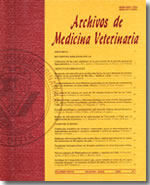Physicochemical parameters associated with the methds of application of salt baths and their field assessment of blood parameters of Atlantic salmon in water pre-smolt stage
Main Article Content
Abstract
Salt baths in the production system of salmonids in fresh water, are important for the prevention and control of different diseases such as saprolegnia fungus. This standard procedure generates a rapid depletion of O2 in the water, leading to a significant increase of CO2, affecting blood parameters associated with animal welfare, such as Na+, Cl-, glucose and protracted hypercarbia. The aim of this study was to evaluate the response field of blood parameters related to fish welfare and the physical-chemical parameters of water to which they are subject during this period, comparing two sets of bath salt. One group of farmed Atlantic salmon (Salmo salar) in the pre-smolt stage was exposed in a salt bath system with the usual conditions and a second to a recirculation system with a waterfall for degasification, with two different exposure periods of one and two hours. The results of the concentration of CO2 in the water show significant variations between the two systems without recirculation compared to the control condition and salt. Significant differences were observed between the recirculating system and the control in blood levels of pCO2 and HCO3, but not pH. Our field data also show that salt baths that are performed regularly at the fish farms generate significant effects on blood parameters associated with animal welfare specifically fish pCO2 and HCO3 causing minor hypercarbia without generating blood acidosis. The addition of water recirculation with a waterfall does not affect blood parameters.

